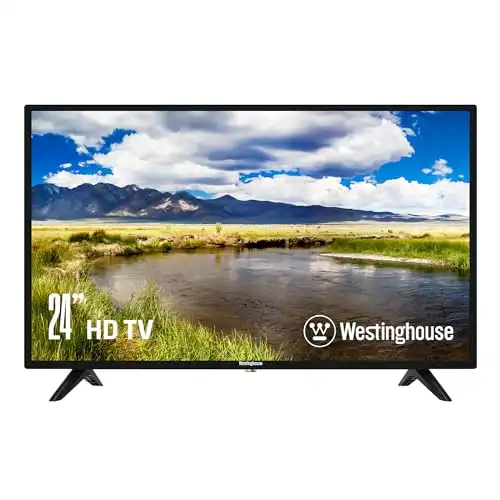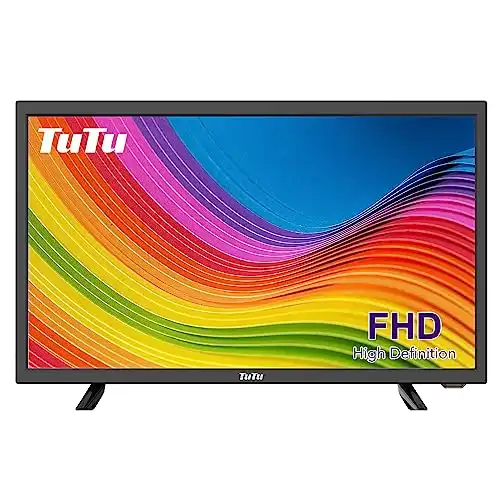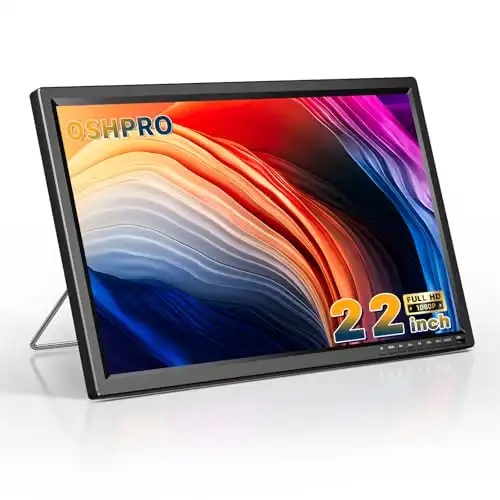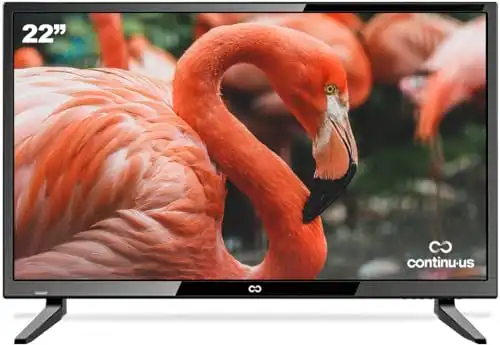This site contains affiliate links to products. We may receive commission for purchases made through these links. Price at time of publish date may change.
Did you know that finding a non smart TV in 2024 feels like searching for a needle in a haystack? As TV makers rush to add streaming apps, we want a simple TV. It should turn on, show our content, and not need updates or the internet.
But here’s the good news – basic TVs still exist, and they’re perfect for many situations. Maybe you’re tired of your smart TV taking forever to load or showing ads. Perhaps you want a monitor for your kitchen that works with your DVD player or gaming console. Or you might need a reliable TV for your RV that won’t stop working when there’s no internet connection.
We checked the market. We found four excellent non-smart TVs. They skip the complicated menus and internet requirements. These TVs do what a TV should. They display your content with good quality. They have simple controls. They last for years without software issues.
One of our picks beat some pricier smart models on picture quality. Another was perfect for spaces needing only a basic TV setup. We’ll show you which TVs are best for each room. We’ll cover which features matter and how to avoid common issues. These include poor sound and confusing controls.
How to Choose the Right Non Smart TV
When shopping for a non smart TV, several key factors can make or break your experience. Let’s look at what really matters:
Screen Size and Resolution Small doesn’t mean low quality. Most basic TVs come in sizes from 19 to 24 inches, perfect for a monitor for home use or as a monitor for kitchen spaces. For these sizes, 720p works fine if watched from a distance. But, 1080p offers sharper images. It’s especially true when using the TV as a monitor for office work.
Connectivity matters. Look for TVs with at least one HDMI port for modern devices, like streaming sticks and game consoles. USB ports let you play media files directly, while VGA inputs work well for older computers. More ports mean more flexibility.
Sound Considerations Many basic TV models have limited built-in audio quality. If sound matters, check if the TV has audio outputs. Look for a headphone jack or optical output for external speakers.
Mounting Options: Consider whether you’ll place the TV on a surface or mount it on a wall. Most non-smart TVs have VESA mounting support. But, check that the pattern size matches your mount.
Meet Our Top Picks:
Why You Should Trust Us
1 – The Winner
The Westinghouse 24-inch stands out as a solid choice for anyone wanting a basic TV that just works. It’s great for small spaces. The display is the perfect size. It’s big enough for comfortable viewing, but small enough to fit on most surfaces.
Picture quality impresses for daily viewing. It’s 720p, not 1080p. At typical kitchen or bedroom viewing distances, the difference isn’t noticeable. Colors are natural. The display handles bright and dark scenes well enough for most content.
The included remote is straightforward, with large, clearly labeled buttons that aren’t overwhelming. This makes it great for older users or anyone tired of complex smart TV remotes. The built-in tuner works well with antennas. It easily picks up local channels and maintains stable reception.
Connectivity is a strong point, with enough ports for typical setups. The HDMI port works well with streaming sticks, consoles, and PCs. The USB port plays basic media. The inclusion of a VGA port makes it particularly useful as a computer monitor.
For kitchen use, the anti-glare screen coating helps reduce reflections from overhead lights. The viewing angles are good enough to watch while moving around the room. This is useful when using it while cooking or working.
2 – Best Budget Non Smart TV
The TuTu 22-inch proves that a basic TV doesn’t need to sacrifice picture quality. This 1080p display has great image quality for its price. It’s a strong choice for anyone wanting a simple but capable TV.
As a monitor for kitchen or office use, it really shines. The full HD resolution lets you read small text easily. So, you can follow recipes or work on spreadsheets. The matte screen finish helps reduce glare from overhead lights.
Connection options cover all the basics well. The HDMI port works with modern devices. The VGA input is for older computers. With RCA inputs, you can connect older gaming consoles and DVD players without adapters.
Picture adjustments offer good flexibility. The TV has presets for different content types. You can fine-tune settings if needed. Colors look natural out of the box, though, so most users won’t need to make many changes.
What’s particularly good about this model is how it handles power outages. When power returns, it auto-turns on and selects the last input. This is perfect for setups needing reliable, user-free TV.
3 – Best Feature-Rich Non Smart TV
The OSHPRO 22-inch stands out by packing useful features into a basic TV package. This model strikes a balance between simplicity and functionality. It’s great for users who want more than a display but don’t need the internet.
Picture quality impresses in daily use. Text looks sharp whether you’re viewing from across the room or using it up close as a monitor for office work. Colors look natural. The screen handles movement well for casual gaming and sports.
The built-in media player deserves special mention. Unlike many basic TVs, this one plays USB files well. It handles various formats smoothly. It’s particularly good as a digital photo frame when not being used for regular viewing.
Connection options cover all common needs. The HDMI port works with modern devices, like streaming sticks and gaming consoles. The AV inputs handle older equipment well. Everything stays connected reliably – no random disconnections or signal drops.
For kitchen use, the adjustable stand really helps. You can angle the screen to avoid glare from windows or lights. It’s easy to readjust it when needed. The matte screen finish also helps reduce reflections.
4 – Best Build Quality Non Smart TV
The CONTINU.US 22-inch is better than typical basic TVs. It has solid construction and attention to detail. Some non-smart TVs feel flimsy. This model’s build quality matches that of bigger brands.
As a monitor for kitchen or office use, it works particularly well. The sturdy stand keeps the TV stable on imperfect surfaces. The matte screen fights glare better than glossy displays. The viewing angles let you see the picture clearly while moving around the room.
Connection options really shine here. Having three HDMI ports instead of the usual one or two makes a big difference in daily use. You can keep a streaming stick, gaming console, and computer connected. This avoids having to swap cables behind the TV.
The picture settings offer good flexibility without getting overwhelming. Most users find the default settings work well, but you can adjust if needed. The screen handles movement smoothly enough for sports and casual gaming.
Sound quality beats most small TVs, though it still has room for improvement. Dialog is clear at normal volumes. The volume can fix most audio issues without external speakers.
Final Thoughts: Choosing Your Perfect Basic TV
After comparing these four non smart TV models, it’s clear that simple TVs still have their place in 2024. Each model fits different needs, so let’s break down who should buy what:
Buy the Westinghouse 24-inch if:
You want reliable daily viewing without any fuss. This TV is best for family rooms and bedrooms. It has good picture quality and easy-to-use parental controls. It’s great for older users who dislike complex menus or internet settings.
Buy the TuTu 22-inch if:
You’re shopping on a budget but don’t want to give up 1080p quality. This TV makes sense for offices or study rooms where you might use it as both a TV and computer monitor. The price-to-performance ratio is unbeatable, especially if you use external speakers.
Buy the OSHPRO 22-inch if:
You need flexibility with media playback. This TV is great for users with many downloaded files. It plays content from USB drives. The adjustable stand makes it perfect for tricky mounting spots. Other TVs wouldn’t work well there.
Buy the CONTINU.US 22-inch if:
You value build quality and want multiple HDMI ports. This TV suits tech-savvy users who switch between different devices often. It’s also good for those willing to pay more for better materials and US-based support.
The Bottom Line
These non-smart TV options show that you don’t need the internet for a good viewing experience. While each model has its quirks, they all offer solid performance for specific needs. The key is to match the TV to your use case. It could be for home entertainment, office work, or basic TV viewing.
Remember, getting the right basic TV comes down to knowing exactly how you’ll use it. Focus on the features that matter to you. Don’t pay extra for unused capabilities.
Common Questions About Non Smart TVs
Can I add streaming services to a non smart TV?
Yes, you can easily add streaming. Just connect a streaming stick (like Roku, Fire TV Stick, or Chromecast) to the TV’s HDMI port. This often works better than smart features. You can upgrade the stick without replacing the whole TV.
Why are non smart TVs hard to find?
TV makers focus on smart TVs. They can collect user data and show ads, which makes them more profitable. However, some users prefer basic TVs that just work. They want options that don’t need an internet connection.
Do non smart TVs have better picture quality?
Not necessarily. Picture quality depends on the display panel and processing, not smart features. However, non-smart TVs often start up faster. They have less input lag. They don’t run background processes for internet features.
What’s the difference between a monitor and a non smart TV?
The main differences are that TVs have tuners for broadcasts and usually have built-in speakers. Monitors usually have higher refresh rates and lower input lag. But, they lack TV features. Many people use non smart TVs as monitors because they offer the best of both worlds.
Will a universal remote work with these TVs?
Most universal remotes work with non smart TVs, often more reliably than with smart TVs. Get a remote that supports your TV’s brand. Or, get a learning remote that can copy signals from the original remote.
How long do non smart TVs typically last?
Non-smart TVs often last longer than smart TVs. They have fewer parts that can fail. They don’t become obsolete due to outdated software. With proper care, a basic TV can easily last 5-7 years or more.
Can I add streaming services to a non smart TV?
Yes, you can easily add streaming. Just connect a streaming stick (like a Roku, Fire TV Stick, or Chromecast) to the TV’s HDMI port. This often works better than built-in smart features. You can upgrade the stick without replacing the whole TV.
Do non smart TVs still exist in 2024?
Yes, while harder to find, several manufacturers still make non smart TVs. These TVs are popular for RVs, kitchens, and offices. They’re for users who prefer simpler TVs without internet features.
Can you connect a non smart TV to WiFi?
No, non smart TVs don’t have built-in WiFi. You can add internet capabilities using a streaming device, like a Roku or Fire TV Stick. Just plug it into the HDMI port.
Which is better: smart TV or non smart TV with Fire Stick?
Many users prefer non smart TV with a streaming stick because:
- You can upgrade your streaming device without buying a new TV
- Streaming sticks often run faster than built-in smart features
- If the streaming device breaks, you only replace the stick, not the whole TV
Why are non smart TVs cheaper?
Non-smart TVs cost less. They have fewer parts and don’t need expensive processors to run smart features. They also don’t require ongoing software development or updates.
Do non smart TVs have HDMI ports?
Yes, most modern non smart TVs come with at least one HDMI port. Higher-end models often have multiple HDMI ports. They connect gaming consoles, streaming devices, and other equipment.
Can I play Netflix on a non smart TV?
Yes, but you’ll need a streaming device (Fire Stick, Roku, etc.), a game console, or a computer with HDMI to watch Netflix.
Do non smart TVs have better picture quality than smart TVs?
Picture quality depends on the display panel and processing, not smart features. Both types can have good or poor picture quality depending on the specific model.
How do I get local channels on a non smart TV?
You can get local channels by:
- Connecting an antenna to the TV’s coaxial input
- Using a cable box
- Subscribing to a service like YouTube TV through a streaming device
What’s the difference between a monitor and a non smart TV?
TVs include tuners for watching broadcasts and usually have built-in speakers. Monitors typically focus on faster response times for computing but lack TV features. Many non smart TVs can serve both purposes.
Do non smart TVs come with remotes?
Yes, all non-smart TVs come with basic remotes. They control volume, channels, inputs, and picture settings.
Can non smart TVs connect to soundbars?
Yes, most non smart TVs can connect to soundbars through:
RCA audio outputs
HDMI ARC port
Optical audio output
3.5mm headphone jack





